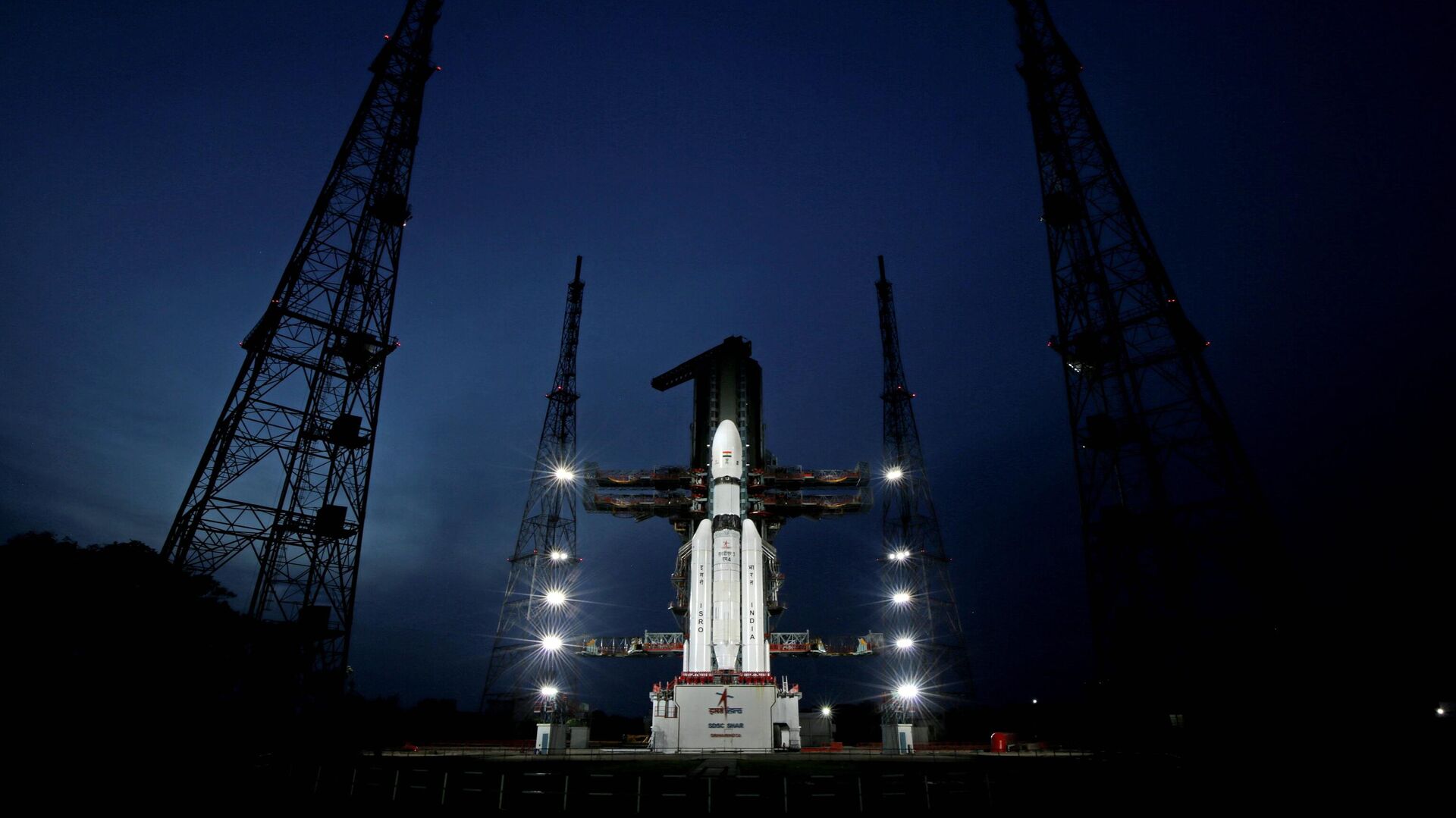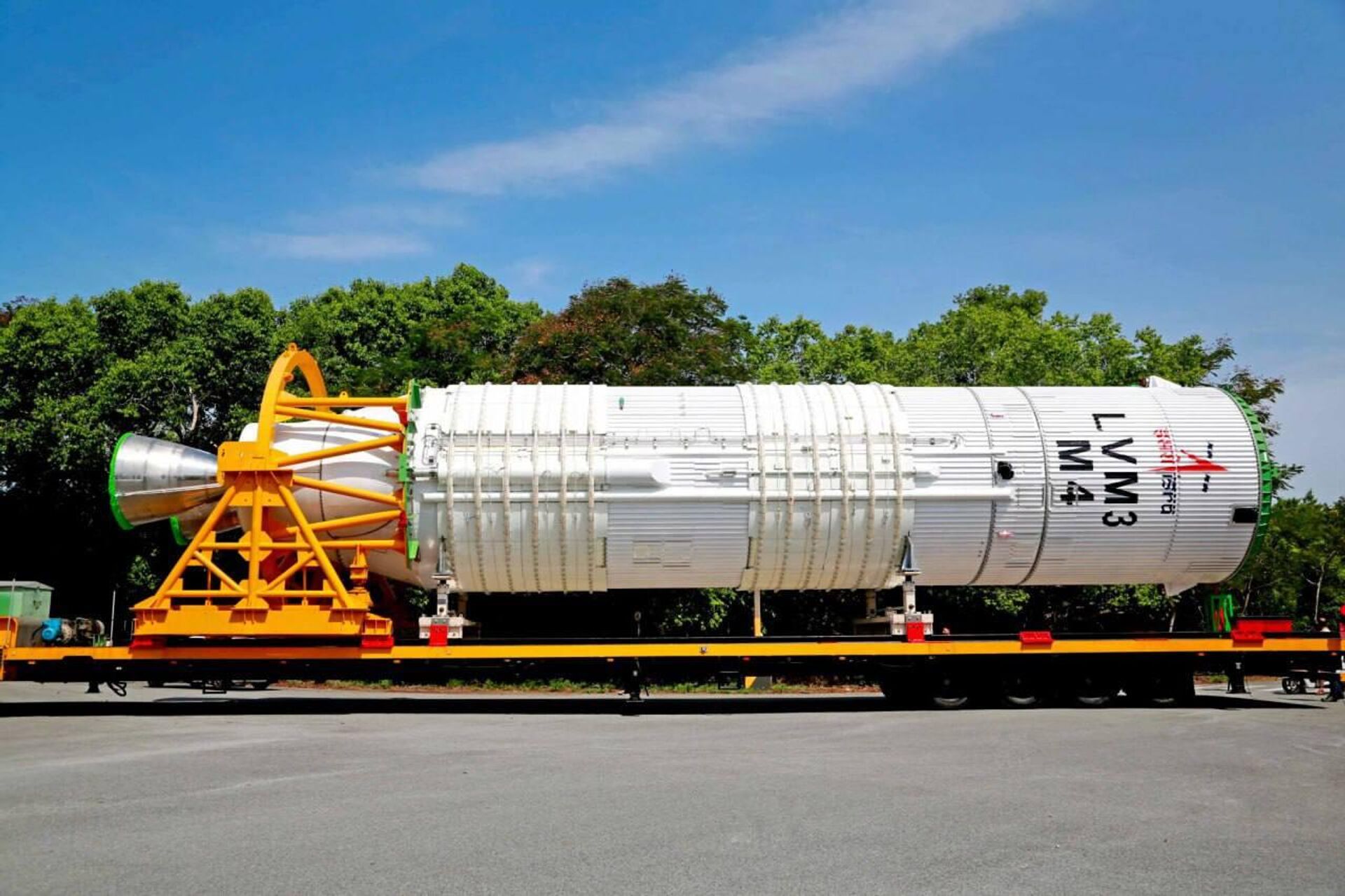https://sputniknews.in/20230713/indias-chandrayaan-3-mission-shooting-for-the-moon-with-third-launch-2956697.html
India’s Chandrayaan 3 Mission Shooting for the Moon with Third Launch
India’s Chandrayaan 3 Mission Shooting for the Moon with Third Launch
Sputnik India
Indian space agency is all set to launch Chandrayaan-3, India’s lunar mission, on July 14, from the Satish Dhawan Space Centre at Sriharikota in Andhra Pradesh. If the mission turns successful, Chandrayaan-3 will become the world’s first mission to soft-land near the Moon’s South Pole.
2023-07-13T13:40+0530
2023-07-13T13:40+0530
2023-07-13T13:40+0530
chandrayaan
indian space research organisation (isro)
space satellite
space industry
space exploration
space rocket
moon
moon landing
lunar soil samples
india
https://cdn1.img.sputniknews.in/img/07e7/07/0d/2977129_0:321:3071:2048_1920x0_80_0_0_9f2ebd2f374d669c578d02edefec0b6b.jpg
Chandrayaan-1 confirmed the presence of water on the moon. However, Chandrayaan-2 crashed on the Moon’s surface after its lander rover, Vikram, lost contact with Earth’s mission control station.Chandrayaan-2 was sent into orbit in September 2019.Now, India is all set to launch its Chandrayaan 3 mission, where it seeks to demonstrate end-to-end capability in safe landing and roving on the lunar surface. Should it be a success, Chandrayaan-3 will become the world’s first mission to soft-land near the Moon’s South Pole.Quick Glimpse at Chandrayaan's JourneyThe mission's landing site is the same as it was for Chandrayaan-2, near the Moon's South Pole at 70 degrees latitude.So far, all spacecraft have landed in the Moon's equatorial region, a few degrees' latitude north or south of the lunar equator. NASA’s Surveyor 7 spacecraft (in 1968) touched down near 40 degrees south latitude, the furthest any spacecraft has gone away from the equator.That said, the total price tag for Chandrayaan-3 is estimated at around USD 77 million (INR 6.1 billion).The 'Soft' Moon Landing ChallengeA 'soft landing' means that a spacecraft lands intact on the Moon's surface and does not, intentionally or otherwise, crash. According to NASA’s Moon Fact Sheet (Released on December 20, 2021), the success ratio of lunar missions undertaken in the last six decades is 60 percent. Of the 109 lunar missions during this period, 61 turned out to be successful, while 48 had failed.“There is no atmosphere on the Moon, [but] reduced gravity. Hence, there is nothing that is slowing down your speed, and it has to be done by the rocket itself,” Dr. Venkateswaran noted. Dr. Venkateswaran also said that the Moon's surface is not smooth but full of craters, gaping pits, and huge boulders, hence finding the right site is also a serious challenge. Furthermore, he emphasized that the landing would be performed with the help of artificial intelligence and other cutting-edge technology.Dr. Venkateswaran pointed out that touching down on the Moon is tougher than on landing on Mars.The mission calls for a two-tonne propulsion module to ferry a 1.75-tonne lander named Vikram and a 26-kilogram, six-wheeled robotic rover called, Pragyan, together to the South Pole. The module will enter the Moon's orbit and manoeuvre into a roughly circular path about 60 miles (100 km) above the surface.Then, the lander will separate from the module and aim for a soft landing on the surface of the Moon. What Happened to Chandrayaan-2?Chandrayaan-2 crashed during its landing in 2019. If the attempt had been successful, the lander and rover would have collected scientific material on the surface for 14 Earth days. A single day on the moon is equivalent to 14 Earth days.On 6 September 2019, Chandrayaan-2 released the Vikram moon lander, but mission officials lost contact with the vehicle as it was just 1.3 miles (2.1 km) above the surface. Although the lander was lost, the orbiter part of the mission, with eight scientific instruments, is still operational, and will continue its seven-year mission to study the Moon. It already has sent back photos of the lunar surface.
moon
india
Sputnik India
feedback.hindi@sputniknews.com
+74956456601
MIA „Rossiya Segodnya“
2023
Deexa Khanduri
https://cdn1.img.sputniknews.in/img/07e6/0c/13/138923_52:0:533:481_100x100_80_0_0_cadf23d341691fc65ff2b22fd1afe584.jpg
Deexa Khanduri
https://cdn1.img.sputniknews.in/img/07e6/0c/13/138923_52:0:533:481_100x100_80_0_0_cadf23d341691fc65ff2b22fd1afe584.jpg
News
en_IN
Sputnik India
feedback.hindi@sputniknews.com
+74956456601
MIA „Rossiya Segodnya“
Sputnik India
feedback.hindi@sputniknews.com
+74956456601
MIA „Rossiya Segodnya“
Deexa Khanduri
https://cdn1.img.sputniknews.in/img/07e6/0c/13/138923_52:0:533:481_100x100_80_0_0_cadf23d341691fc65ff2b22fd1afe584.jpg
indian space agency, chandrayaan-3, india’s lunar mission, satish dhawan space centre, sriharikota, andhra pradesh, moon’s south pole, chandrayaan-1, chandrayaan-2, vikram, chandrayaan-2, nasa, dr t v venkateswaran, soft landing, nasa’s moon fact sheet,
indian space agency, chandrayaan-3, india’s lunar mission, satish dhawan space centre, sriharikota, andhra pradesh, moon’s south pole, chandrayaan-1, chandrayaan-2, vikram, chandrayaan-2, nasa, dr t v venkateswaran, soft landing, nasa’s moon fact sheet,
India’s Chandrayaan 3 Mission Shooting for the Moon with Third Launch
Deexa Khanduri
Sputnik correspondent
India's space agency is all set to launch its lunar mission, Chandrayaan-3, on July 14, from the Satish Dhawan Space Centre at Sriharikota in Andhra Pradesh.
Chandrayaan-1 confirmed the presence of water on the moon. However,
Chandrayaan-2 crashed on the Moon’s surface after its
lander rover, Vikram, lost contact with Earth’s mission control station.
Chandrayaan-2 was sent into orbit in September 2019.
Now, India is all set to launch its Chandrayaan 3 mission, where it seeks to demonstrate end-to-end capability in safe landing and roving on the lunar surface.
As per Indian Space Research Organisation (ISRO) officials, Chandrayaan-3 will reach the Moon almost a month after its lander, Vikram and rover, Pragyaan, is scheduled for August 23-24, depending on when the Sun rises over the Moon. However, if the landing gets delayed, ISRO will reschedule the landing for September.
Should it be a success, Chandrayaan-3 will become the world’s first mission to soft-land near the Moon’s South Pole.
Quick Glimpse at Chandrayaan's Journey
The mission's landing site is the same as it was for Chandrayaan-2, near the
Moon's South Pole at 70 degrees latitude.So far, all spacecraft have landed in the Moon's equatorial region, a few degrees' latitude north or south of the lunar equator. NASA’s Surveyor 7 spacecraft (in 1968) touched down near 40 degrees south latitude, the furthest any spacecraft has gone away from the equator.
That said, the total price tag for Chandrayaan-3 is estimated at around USD 77 million (INR 6.1 billion).
“The Chandrayaan journey first took off in 2008, with the launch of Chandrayaan-1, which set its sights on orbiting around the Moon. Chandrayaan-2 was launched in 2019 aiming for a soft-landing on the Moon, but the lander failed due to technical reasons. Nevertheless, Chandrayaan-3 will ensure that soft landing on the Moon,” Dr. T. V. Venkateswaran, Scientist at Vigyan Prasar, Dept of Science and Technology, told Sputnik.
The 'Soft' Moon Landing Challenge
A 'soft landing' means that a spacecraft lands intact on the Moon's surface and does not, intentionally or otherwise, crash. According to
NASA’s Moon Fact Sheet (Released on December 20, 2021), the success ratio of
lunar missions undertaken in the last six decades is 60 percent. Of the 109 lunar missions during this period, 61 turned out to be successful, while 48 had failed.
“There is no atmosphere on the Moon, [but] reduced gravity. Hence, there is nothing that is slowing down your speed, and it has to be done by the rocket itself,” Dr. Venkateswaran noted.
"It’s one time shot for astronauts giving them smaller margins for error," the scientist added.
Dr. Venkateswaran also said that the Moon's surface is not smooth but full of craters, gaping pits, and huge boulders, hence finding the right site is also a serious challenge. Furthermore, he emphasized that the landing would be performed with the help of artificial intelligence and other cutting-edge technology.
Dr. Venkateswaran pointed out that touching down on the Moon is tougher than on landing on Mars.
The Chandrayaan-3 mission's main objectives are to demonstrate a safe and soft landing on the lunar surface, and show the rover roving on the Moon while conducting on-site scientific experiments.
The mission calls for a two-tonne propulsion module to ferry a 1.75-tonne lander named Vikram and a 26-kilogram, six-wheeled robotic rover called, Pragyan, together to the South Pole. The module will enter the Moon's orbit and manoeuvre into a roughly circular path about 60 miles (100 km) above the surface.
Then, the lander will separate from the module and aim for a soft landing on the surface of the Moon.
What Happened to Chandrayaan-2?
Chandrayaan-2 crashed during its landing in 2019. If the attempt had been successful, the lander and rover would have collected scientific material on the surface for 14 Earth days. A single day on the moon is equivalent to 14 Earth days.
On 6 September 2019, Chandrayaan-2 released the Vikram moon lander, but mission officials lost contact with the vehicle as it was just 1.3 miles (2.1 km) above the surface. Although the lander was lost, the orbiter part of the mission, with eight scientific instruments, is still operational, and will continue its seven-year mission to study the Moon. It already has sent back photos of the lunar surface.





